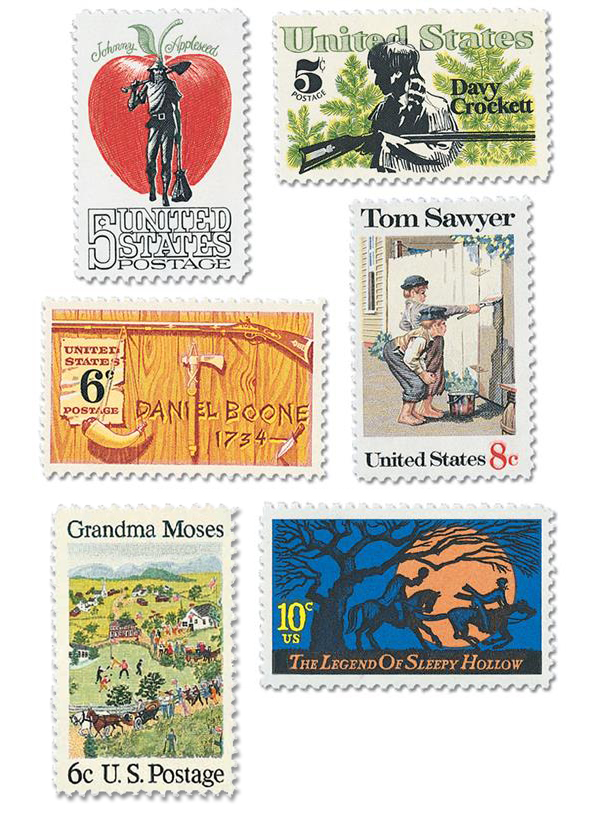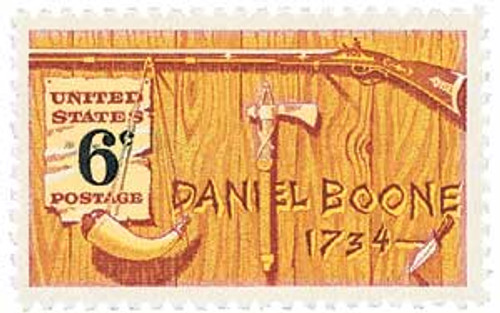
# 1317/1548 - Complete Set of 5, 1966-74 American Folklore
Get the Complete American Folklore Series and Save
American Folklore Series
The American Folklore stamp series captured the things that make our nation unique. It honored some of the people and tales that have played an important role in our nation’s culture.
The first honoree in the series was John Chapman, popularly known as Johnny Appleseed. The stamp was issued on September 24, 1966, (two days before his 192nd birthday) in his hometown of Leominster, Massachusetts. Chapman was an American pioneer who traveled over 100,000 square miles planting apple orchards. Most of the apples he grew were meant for cider, rather than eating, but they provided much-needed sustenance on the frontier, where water was riddled with bacteria. Among the apples we can credit to Johnny Appleseed are the delicious and golden delicious.

The next stamp in the series honored Davy Crockett. It was issued on his 181st birthday, August 17, 1967, in San Antonio, Texas, where he died fighting the Battle of the Alamo. Many legends surround Davy Crockett, who was a master storyteller with a gift for exaggeration. Crockett told a story about a raccoon that gave up when he spotted him on a hunt. He also claimed to kill 105 bears in just seven months. One fictionalized account of Crockett claimed he could “run faster, jump higher, squat lower, dive deeper, stay under longer, and come out drier than any man in the whole country.”

Daniel Boone joined the series on September 26, 1968 (the 148th anniversary of his death). His stamp was issued in Frankfort, Kentucky, where his remains were supposedly reburied. Boone was one of the greatest pioneers in American history. This frontiersman paved the way for settlement of Kentucky by leading settlers from North Carolina through the Cumberland Gap into that territory. Boone’s exploits as a frontiersman, hunter, and trapper earned him a special place in American folklore.

Grandma Moses was the next honoree in the series, with her stamp issued on May 1, 1969, in Washington, DC to coincide with Senior Citizen’s Month. Grandma Moses (born Anna Mary Robertson) began painting when she was in her 70’s. With no formal art training, she painted simple, yet realistic, scenes of country life that were praised by critics.

The series continued in 1972 with a stamp honoring Tom Sawyer. It was issued on October 13 in Mark Twain’s childhood hometown of Hannibal, Missouri, which served as the setting for Tom Sawyer. Tom Sawyer was created by Mark Twain (the pen name of Samuel L. Clemens) to represent the typical adventurous American boy. The Adventures of Tom Sawyer shared stories (possibly based on those Twain heard from real people) about Sawyer’s life in the fictional town of St. Petersburg (inspired by Hannibal, Missouri) along the Mississippi River. The book is considered a masterpiece of American literature. Twain is considered one of the greatest American fiction writers and America’s greatest humorist.

The final stamp in the series honored Washington Irving’s famous folk tale, “The Legend of Sleepy Hollow.” The stamp was issued on October 10, 1974, just in time for use on Halloween mail. It was issued in North Tarrytown, New York, where the fictional story takes place. In the story, school teacher Ichabod Crane is chased out of town by a headless horseman and is never heard from again. The tale incorporates German writer Karl Musaus’ story of an old man who didn’t believe in ghosts. Approached by a headless horseman, the old man is forced to take a terrifying ride through the woods with the ghoulish creature. Irving’s original short story remains one of the earliest works of American fiction still widely read today.
Get the Complete American Folklore Series and Save
American Folklore Series
The American Folklore stamp series captured the things that make our nation unique. It honored some of the people and tales that have played an important role in our nation’s culture.
The first honoree in the series was John Chapman, popularly known as Johnny Appleseed. The stamp was issued on September 24, 1966, (two days before his 192nd birthday) in his hometown of Leominster, Massachusetts. Chapman was an American pioneer who traveled over 100,000 square miles planting apple orchards. Most of the apples he grew were meant for cider, rather than eating, but they provided much-needed sustenance on the frontier, where water was riddled with bacteria. Among the apples we can credit to Johnny Appleseed are the delicious and golden delicious.

The next stamp in the series honored Davy Crockett. It was issued on his 181st birthday, August 17, 1967, in San Antonio, Texas, where he died fighting the Battle of the Alamo. Many legends surround Davy Crockett, who was a master storyteller with a gift for exaggeration. Crockett told a story about a raccoon that gave up when he spotted him on a hunt. He also claimed to kill 105 bears in just seven months. One fictionalized account of Crockett claimed he could “run faster, jump higher, squat lower, dive deeper, stay under longer, and come out drier than any man in the whole country.”

Daniel Boone joined the series on September 26, 1968 (the 148th anniversary of his death). His stamp was issued in Frankfort, Kentucky, where his remains were supposedly reburied. Boone was one of the greatest pioneers in American history. This frontiersman paved the way for settlement of Kentucky by leading settlers from North Carolina through the Cumberland Gap into that territory. Boone’s exploits as a frontiersman, hunter, and trapper earned him a special place in American folklore.

Grandma Moses was the next honoree in the series, with her stamp issued on May 1, 1969, in Washington, DC to coincide with Senior Citizen’s Month. Grandma Moses (born Anna Mary Robertson) began painting when she was in her 70’s. With no formal art training, she painted simple, yet realistic, scenes of country life that were praised by critics.

The series continued in 1972 with a stamp honoring Tom Sawyer. It was issued on October 13 in Mark Twain’s childhood hometown of Hannibal, Missouri, which served as the setting for Tom Sawyer. Tom Sawyer was created by Mark Twain (the pen name of Samuel L. Clemens) to represent the typical adventurous American boy. The Adventures of Tom Sawyer shared stories (possibly based on those Twain heard from real people) about Sawyer’s life in the fictional town of St. Petersburg (inspired by Hannibal, Missouri) along the Mississippi River. The book is considered a masterpiece of American literature. Twain is considered one of the greatest American fiction writers and America’s greatest humorist.

The final stamp in the series honored Washington Irving’s famous folk tale, “The Legend of Sleepy Hollow.” The stamp was issued on October 10, 1974, just in time for use on Halloween mail. It was issued in North Tarrytown, New York, where the fictional story takes place. In the story, school teacher Ichabod Crane is chased out of town by a headless horseman and is never heard from again. The tale incorporates German writer Karl Musaus’ story of an old man who didn’t believe in ghosts. Approached by a headless horseman, the old man is forced to take a terrifying ride through the woods with the ghoulish creature. Irving’s original short story remains one of the earliest works of American fiction still widely read today.











